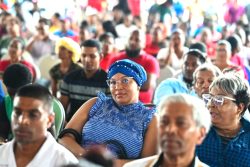Just minutes before midnight on December 31, Carlisa Matthews was shot dead allegedly by her former partner.
Her murder capped another deadly year for women and girls in our country despite the administration’s repeated promises to prioritise domestic violence.
Last year alone we witnessed a violent upsurge in the crimes perpetrated against the women in our society and based on the information gathered from the press we know this much: our female population is being eliminated one separation after another.
 Consider how many women died last year after breaking off a relationship and or threatening to end intimate partnerships. What is even more troubling is that many of those who made headlines were teenagers – young women still in school yet deeply involved in complicated relationships. Take for example, young Theiana Andrews, 17, who was shot dead in her home allegedly by a spurned older lover who also has a wife and two children.
Consider how many women died last year after breaking off a relationship and or threatening to end intimate partnerships. What is even more troubling is that many of those who made headlines were teenagers – young women still in school yet deeply involved in complicated relationships. Take for example, young Theiana Andrews, 17, who was shot dead in her home allegedly by a spurned older lover who also has a wife and two children.
After what seems to be one of the deadliest years for women and girls, Human Services Minister Jennifer Webster took the bold step of speaking out once more about domestic violence at her ministry’s year end press conference.
The only information Minister Webster could have reasonably reported was that the situation has reached crisis levels. And while it might have been expected that she would tell us that an urgent national plan is needed to address the issue, she made no such disclosures.
While Minister Webster and her team at the ministry have direct responsibility on the issue, a national response would include all the political players, civil society and every community across this country. A national response would seek to understand how the violence in our society is structured by cultural, historical and even political forces; the forms the violence takes; and, importantly, identifying and addressing the root causes.
The problem of violence against women and girls in our society is persistent and pervasive, and we are well aware of the implications of the absence of a concerted national effort on the issue. We are living in a country where the political leadership are so busy attacking each other that hardly any time is left to attack the real problems in our society such as this scourge of gender-based violence.
The reality is that we live in a violent society. Our exposure to violence is pervasive, from ruthless murders, rape and robberies to child molestations and domestic abuse. The violence is shaped by a number of factors, related to weak enforcement of laws, attitudes that condone or normalise such violence, the absence of timely justice, and a culture that trivialises domestic disputes. Therefore, it is important that we examine the culture of violence against women and girls within the context of violence in the wider society.
We don’t often draw links but they exist—from the public murder of a man in broad daylight in one of city streets which was caught on camera to the Old Year’s Day murder of Carlisa Matthews, also in full public view on a city street. How do we intend to break the cycle of violence against women and girls if violence and a seeming acceptance of it have become so normal in our society?
Indeed, the culture of silence which permeates every aspect of our society, including our failure to speak out against misogyny, racism, homophobia etc, feeds into our attitudes and response to violence against women and girls. Not only do we need to break the cycle, we need to develop a culture of advocacy on the range of issues plaguing our society.
Not long ago, we launched a five-year national policy on domestic violence and followed up on this with progressive legislation on sexual offences. But policies and laws are not enough to protect our women and girls, we need to implement the laws and build the supporting institutions required for effective implementation.
This includes prosecuting the crimes routinely being perpetrated in our homes against women; crimes which are culturally accepted as “private matters between a man and a woman”. We need to become so involved in the fight against domestic abuse that at no time should any person in our society feel comfortable enough to strike another in public or in private.
It is true that the Domestic Violence Act needs amending to offer greater protection for women but have we missed the ongoing campaign by the stakeholder community here which continues to advocate for full implementation of the relevant legislation? As they have rightfully observed, our government must be held accountable for implementing all the laws that are available to protect women and girls in our society.
In a letter to the press earlier last year, several advocacy groups, including ChildLink, Help and Shelter and Red Thread said: “We are living in a country with a government which has failed to guarantee the right of its citizens and in particular its children and women, to live lives free from the brutality and horror of sexual violence, and the right to prosecution and redress from these crimes against humanity.” And they questioned why after three years the Sexual Offences Act, 2010 is still to deliver justice to the hundreds of victims of sexual offences in Guyana.
It is widely recognised across countries that implementing the laws is as important as passing them in reducing violence and creating a safer environment for women and girls. Why then do we continue to pass laws in this country, sign treaties and design policies when little attention is paid to implementation?
We have not seen much progress as it relates to putting in place the structures which will facilitate the implementation such as adequate police training, community-wide sensitisation programmes and rehabilitation projects targeting men who act violently towards their partners. In addition to the legislation, we need the supporting structures, which seem to have escaped our policymakers.
Further, there is not a single programme in this country – which I am aware of – that was designed to help violent men challenge and change their behaviour and research indicates how important it is to help these men. We are counting on the system to find these perpetrators and to jail them, but we are also interested in whether they are being rehabilitated.
In sum, as we work on breaking the cycle of violence against women and girls in our society, we need coordination at the national and political levels and coordination on the ground between the relevant authorities. But more important, we need laws that work not protection on paper which means nothing to the women and girls in our society who are being beaten, maimed, and murdered year after year.
Have a question or comment? Connect with Iana Seales at about.me/iseales










